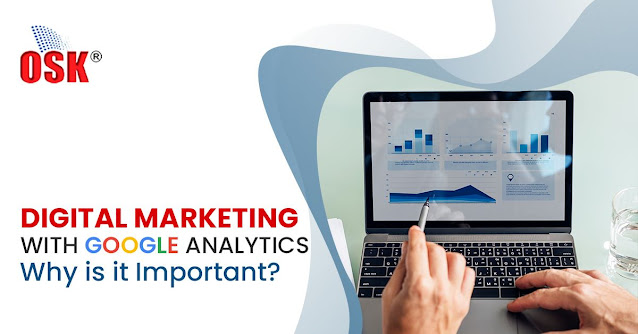Digital Marketing with Google Analytics. Why is it important?
Google Analytics, which is a part of the Google marketing platform is a popular tool for digital marketing and is available as a free as well as a paid service. It is a website tracking tool that collects and displays user behaviour data and their interactions with your website. It is used to guide digital marketing campaigns and evaluate their effectiveness. We are a leading Digital marketing company in Nagpur, and one of the Best seo agencies in Nagpur. Let us show you the various factors why Google Analytics is very important for digital marketing.
1. Tracking website traffic sources
The basic information required is to know how many users visit your website per day, their location and the basic purpose of their visit. Some important metrics you can observe are:
Organic
– An efficient SEO campaign will
indicate that your website is getting a lot of traffic organically from a
search engine. This can be gauged if your website is getting displayed in the
first few results of a keyword search.
Social
media – Social media posts can be used to
generate traffic to your website. An increase in social media followers would
mean increased chances of redirecting traffic to your website. Contact us now, and as a top Social media marketing company in
Nagpur, we will give you the
detailed information.
Email
– Embedded links in a marketing email are a common tool used by digital
marketers to generate traffic to your website as well as leads too.
Paid
search – Here, the advertisers are allowed to
show ads on search engine results pages (SERPs) such as Google and Bing. By
using Google Analytics, you can track metrics like PPC (pay-per-click) and CPC
(cost-per-click) of paid search campaigns to know their effectiveness.
Referral – Google Analytics reports the number of users visiting your website from sources other than its search engine. For example, when a user clicks on a link that is present on some other site and reaches your website, it is known as referral traffic.
2. Site Content and engagement rate
Once users visit your website, they will
browse several pages of the website. Each user will have different intentions
for visiting those pages. They could be researching product delivery locations
or checking your achievements and credentials or some other information. Once
the user intent is established, it becomes easier for the digital marketing
team to create targeted offers and content for their specific needs. Through
Google Analytics, you can find out how long a user went through a particular
page and whether it was profitable or not. This analysis is done by checking
the following page statistics:
Landing
page – This lets you know the website
conversion rate as it is the starting point through which a user will browse
other pages of your website. If the desired outcome is achieved, then that
landing page is given credit for it. For example, if a user lands on a shopping
site homepage and ends up buying a product, then that homepage is accredited
with converting that user into a customer. This shows how important a good user
experience is on the landing page for browsing further.
Exit
page – This is the page where the user last
views your website and leaves which indicates whether your marketing campaign
is successful or not. For example, if you have a shopping website, you will
want users to exit only after they view the product sale confirmation page
(thank you page). Suppose, they exit your website at the payment page, you know
that something went wrong and resulted in an incomplete product sale. Google
Analytics helps you in tracking and analysing a user’s journey from the landing
page to the exit page.
All
pages – Get periodic data about the most
visited pages of a particular date and the duration of the visit. This is
useful to track down the pages receiving the maximum traffic on your website.
Through Google Analytics, you can view the following metrics:
Pageviews
– Each time a user begins a session by opening and viewing any page on your
website, it is considered to be one page view.
Entrances
– The entry gates to your website.
Bounce
Rate – The rate at which users exit your
website almost immediately after a visit to the home page.
Page Value – Revenue generated through your web pages.
3.
Audience monitoring
Google Analytics assesses your website audience by its users over time like a week, month or year. They are then grouped based on their interests/ characteristics and user behaviour is analysed which enables the identification of the user interests and benefits. This helps in modifying marketing strategies accordingly. For example, if you come to know that one of your products is a hot seller amongst teenagers, you can effectively target your marketing efforts towards them.
Reach
out today for a customised digital marketing
campaign.
Visit https://www.oskitsolutions.in/







Comments
Post a Comment